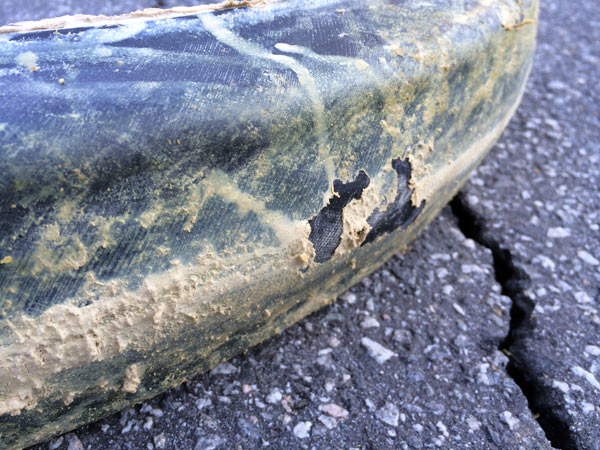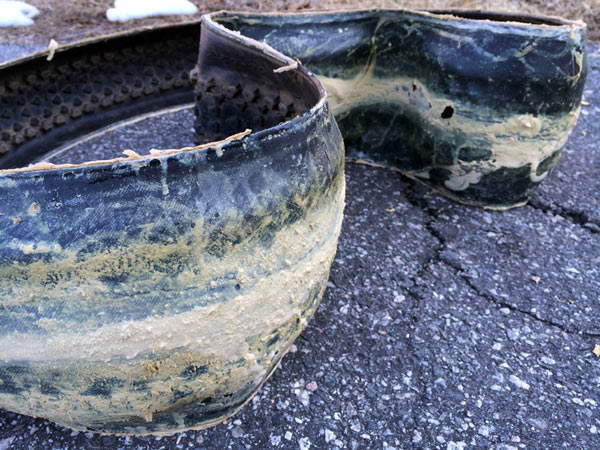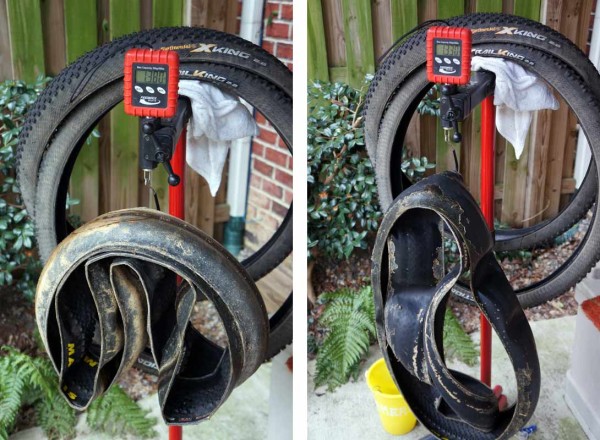Around the Bikerumor office, there’s always a collection of wheels and tires to be tested. Sometimes, that means re-using tires on new rims, or just switching things around to suit a particular type of ride. And that means we go through a good bit of sealant, sometimes mixing them (against the advice of the brands – fortunately, nothing’s exploded so far).
As such, we’ve seen plenty of semi-solidified sealant in every state of congealment from pouring straight onto the floor to us simply wanting to scrap the tires because it looks like lava rock painted beige. That got us thinking. What causes the sealant to dry up? How often should we be checking it? Replacing it? And, in the event you find zero moisture in your tire, how can you get it out? Or should you?
We spoke to Bob Nunnink, U.S. Domestic Sales & Marketing Manager for Stan’s NoTubes, and John Vargas, President of Orange Seal Cycling, to get some ideas. Oh, and then we spent two hours of our lives that we’ll never get back peeling mixed, dried sealant out of a set of Maxxis Ikons to see just how much weight sealant really adds…
How long should a standard application of sealant last?
STAN’S: Two to seven months, depending on heat and humidity. The hotter and drier the conditions, the faster it evaporates.
ORANGE SEAL: Depending on temps and humidity, ride time and geography, you should get one to three months for tubeless set ups, and up to six months in a tube.
Other than heat and dryness, is there anything that can cause it to dry up quicker?
STAN’S: Using CO2 inflators can cause the crystals to congeal and solidify.
ORANGE SEAL: Punctures, especially the ones you don’t know about, and the porosity of the tires. It’s impossible to tell how much is going to be used just to close up the tire’s bead and porosity. If you let it sit for a couple weeks, it’s going to concentrate in the tire and can pool and vulcanize a bit, so we recommend rotating your tires at least once a week or more if you’re not going to be riding. That helps it remain more fluid.

How often should you check the sealant?
STAN’S: With ours, you can shake the tire (off the bike) and if you hear it sloshing around, you’re good to go. If you don’t hear anything, add a couple more ounces.
ORANGE SEAL: We recommend checking it after 30 days, then every 15 days. You can do that by popping the bead, or just listening to it. What we do is just top it off with an ounce through the valve stem every 30 days and don’t worry about it. Yeah, that’s going to add a bit of weight over time, but most of the weight is the liquid that’s evaporating out. It’s really insignificant compared to the benefit, and the rubber wears down on the outside, which should offset it.
Is there an easy way remove old sealant? Should we remove it?
STAN’S: We use liquid soap and water. A lot of the dried sealant inside the tire is sealing up any of the tire’s porosity, and we say leave it in there. Just wipe out any big chunks. As much as people think they’d like it, there’s not a solvent that we recommend.
ORANGE SEAL: With our sealant, you don’t have to remove it. It doesn’t fall out of solution, so you’re topping off solution to solution. But if you’re a real weight weenie, you can just peel it off. I will recommend that if you pop the bead, you should clean the bead of any sealant that sealed the previous imperfections between the bead and the wheel. (Editor’s note: From my experience, Orange Seal is the easiest to peel off when completely dry. But it’s still not fun.)
HOW MUCH WEIGHT DOES SEALANT ADD?
Two Maxxis Ikon 3C EXO 29×2.2 tires were weighed with a summer’s worth of sealant (a mix of Orange Seal and Cafe Latex, I believe), all of which was allowed a couple months of non-use to dry completely. Weight with dried sealant was 1380g, and weight cleaning was 1330g. So, 50 grams of rotational weight saved for two hours of work that you couldn’t pay me to do again.
Perspective: The weight of the tires when new was 1314g, and a recommended serving of sealant weighs about 56-60g per tire. So, the 1380 weight shows accumulation that could continue to add up after frequent top-offs.
The tires were cleaned of most of the sealant before reweighing. I left a bit of the really thin sidewall layers, but only a bit.
My takeaway? Depending on the type of sealant used, I’ll probably wipe it out every two to four months and replace with fresh sealant, leaving the thin layer shown above. Unless the tires wear out first.
Stay tuned for part two in the near future, which dives into more of the science behind the various chemicals used and their interactions with rims and tires.


